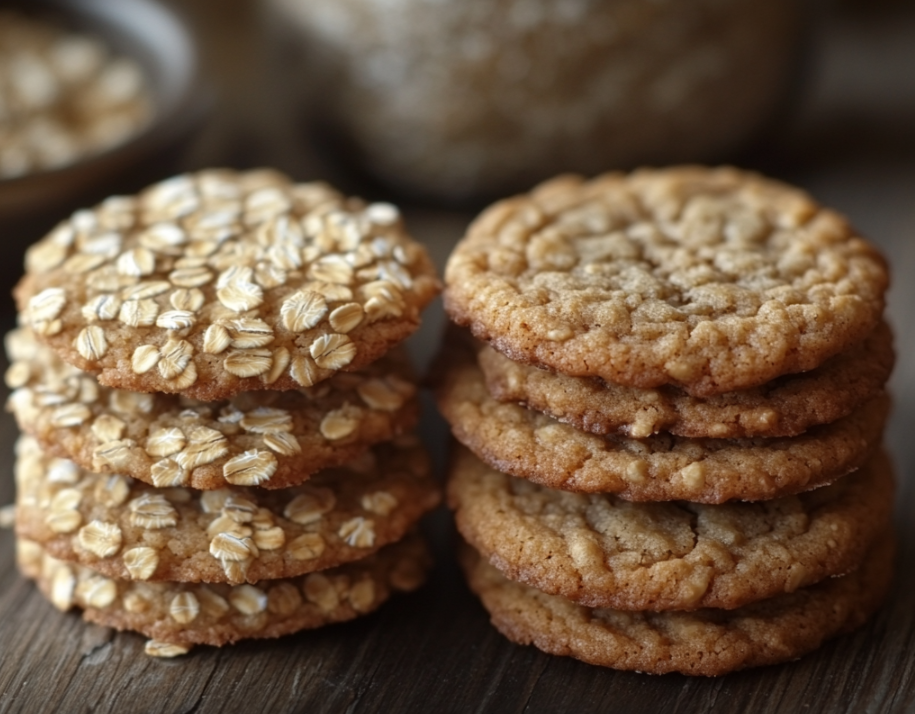If you’ve been baking cookies and wondered why some recipes specifically recommend rolled oats over quick oats, you’re not alone. While both are types of oats, they have significant differences that impact the texture and consistency of baked goods. This article will explore why quick oats may not be the best choice for cookies, along with tips for adjusting your recipes if that’s all you have on hand.
Types of Oats Used in Baking
When baking with oats, choosing the right type can make a big difference. Here’s a look at the main types of oats and how they affect cookies:
- Old-Fashioned/Rolled Oats: These oats are steamed and flattened, retaining a chewy texture that stands up well in cookies. They are the go-to for traditional oatmeal cookies due to their hearty consistency.
- Quick Oats: Quick oats are rolled oats that have been cut into smaller pieces and steamed longer, resulting in thinner flakes. They absorb moisture faster, which can affect the texture of cookies.
- Instant Oats: These oats are even more processed than quick oats and have a finer texture, making them less suitable for baking cookies as they tend to create a mushy consistency.
For more insights, check out this guide on no-bake chocolate oatmeal cookies, which discusses how different oat types can impact texture.

Why Texture Matters in Cookies
Texture is one of the key factors in cookie quality, and oats play a significant role in achieving the right consistency. Rolled oats hold their shape during baking, providing a chewy and chunky texture. On the other hand, quick oats break down more easily and absorb more moisture, resulting in a softer, denser cookie. If you’re aiming for that classic chewy texture, using rolled oats is the way to go.
Quick oats can also cause the cookie dough to dry out quickly, leading to a crumblier texture. Learn more about maintaining cookie moisture in this article on how to keep oatmeal cookies moist.

Why You Shouldn’t Use Quick Oats in Cookies
1. Processing Differences Affect Texture
Quick oats are processed to cook faster, which involves cutting them into smaller pieces and steaming them longer. This extra processing creates a finer texture that doesn’t provide the same chewiness as rolled oats, making cookies feel denser and less hearty.
2. Moisture Absorption
Quick oats have a higher surface area due to their smaller size, causing them to absorb moisture faster than rolled oats. This can lead to a drier dough, resulting in cookies that are thicker and less chewy than desired.
3. Inconsistent Baking Results
When using quick oats, the faster cooking time can lead to unevenly baked cookies. The oats may soften too much before the rest of the dough is fully baked, resulting in a mixture of textures within the same batch.

When Can You Use Quick Oats in Cookies?
There are some scenarios where you might consider using quick oats in cookies, such as:
- If it’s the Only Option Available: While rolled oats are preferable, you can use quick oats if that’s all you have, but expect a different texture.
- Blending Oats for Balanced Texture: Mixing rolled oats with quick oats can help you achieve some chewiness while also adding a bit of softness.
- Adjusting the Recipe to Compensate: Adding extra moisture, such as a little more butter or an extra egg, can help counteract the drier nature of quick oats.
For more details on troubleshooting baking issues, see why your oatmeal chocolate chip cookies might be hard.
Adjusting Recipes When Using Quick Oats
If you decide to go ahead with quick oats, try these tips to improve your results:
- Add Extra Liquid: Since quick oats absorb moisture faster, consider adding a bit more liquid to the dough, such as milk or another egg.
- Reduce Baking Time: Quick oats cook faster, so reducing the baking time slightly can help prevent the cookies from becoming too dry.
- Combine Different Types of Oats: Mixing rolled oats with quick oats can help balance the texture, giving you the best of both worlds.
Are Quick Oats Less Nutritious?
While the nutritional differences between quick oats and rolled oats are minimal, quick oats have a slightly higher glycemic index due to being more processed. This means they may cause a quicker spike in blood sugar. However, the overall nutritional content, including fiber and protein, remains largely the same.
For more on how oat processing affects nutritional value, you can check out why oatmeal chocolate chip cookies might turn out hard.
Frequently Asked Questions (FAQs)
1. Can I replace rolled oats with quick oats in any cookie recipe?
Yes, but be aware that the texture will be different. Quick oats will make the cookies softer and denser.
2. Why do cookies turn out flat when using quick oats?
Quick oats can absorb too much moisture too quickly, causing the dough to spread out more during baking.
3. How can I make my cookies chewier if I only have quick oats?
Add extra moisture to the dough, such as an extra egg or a bit of milk, to help retain a chewier texture.
4. Are quick oats more processed than rolled oats?
Yes, quick oats undergo additional processing, which involves cutting and steaming them longer, making them more refined than rolled oats.
5. Can I use steel-cut oats in cookie recipes?
Steel-cut oats are not suitable for cookies because they are less processed and have a firmer texture that doesn’t soften adequately during baking.
Conclusion
Using quick oats in cookie recipes can result in a different texture and moisture level than expected, leading to softer, denser cookies. If you’re aiming for a classic oatmeal cookie texture, rolled oats are the better choice. However, with some recipe modifications, quick oats can still be a suitable substitute.

